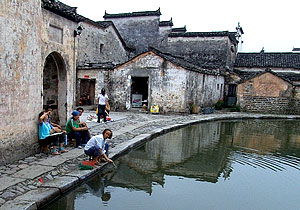Hongcun Village

Hongcun, the shooting spot of a number of films such as Crouching Tiger, Hidden Dragon, is located at the foot of Mt. Huangshan, Anhui Province. Renowned for its preserve of non-urban settlements that reflect the architecture style in Chinese Ming Dynasty (1368-1644) and Qing Dynasty (1644-1911), Hongcun was made a UNESCO World Heritage Site in 2000, together with a nearby village Xidi.
Though a small village, it is said that from a bird's eye view, Hongcun Village resembles a lying buffalo, with the nearby Leigang Hill as head, two old trees on the hill interpreted as its horns, houses of the village the body, Nanhu lake (in the southern part of the village) marks the belly, and four bridges across a stream can be interpreted as four legs.
The ancestors of Hongcun represent ingenious wisdom in the design of the village, in which water plays a very important role. Taking full advantage of geography, the villagers of Hongcun have built a comprehensive water system across the whole village, which not only supply water to every family, but also regulate the climate around the village.
The residential buildings in Hongcun represent the typical Anhui-style architecture. The approximately 150 residences of Ming or Qing Dynasty are all decorated with traditional style of black brick, white stone, and delicately carving wood. Typical structures in Hongcun include Chengzhi Hall, a magnificent wooden residence of late Qing Dynasty; Jingde Hall, representative of early Qing Dynasty architecture style; Taoyuan Residence, of which wood carving and brick carving are of great value to the appreciation of Anhui-style art and culture.